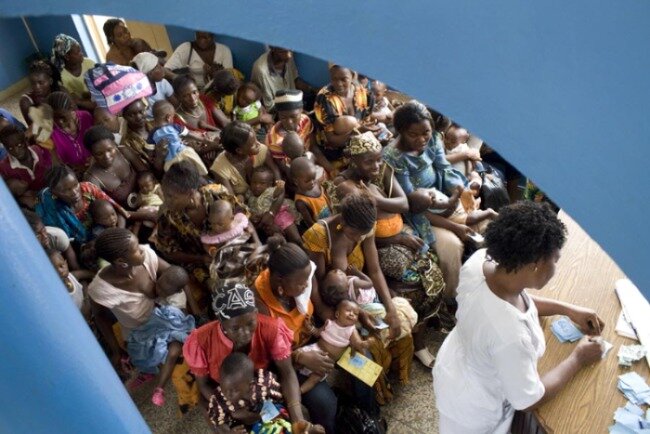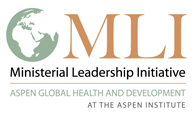Tough economic times may put developing countries in driver's seat
 Women and children wait to be seen on the first day of the free care initiative in Sierra Leone Photo Credit Dominic Chavez |
There’s a lot of discussion now about the upcoming federal government budget debates following the Obama administration’s request to Congress. Those supporting global health already have voiced opposition about several cuts in funding for programs.
But funding is only part of the issue.
Finding ways to become more efficient – and saving money -- is also a critical focus of what’s going on behind the scenes. Some of that is a byproduct of a new approach under the administration’s Global Health Initiative: Fund the priorities of developing countries rather than solely the priorities of the donors.
This movement of country-led development has been around for a long time, but it is gaining steam now.
I believe there are two reasons for this. One is that developing countries, having gained a foothold in funding their own priorities, are showing stronger results when they are in the driver’s seat. Second, the tough economic times have caused several developing countries to internally face up to a key question: What do we do if our traditional donors no longer support our health programs?
Given the difficult economic climate, there is little margin for error. Donor-supported programs have to yield results. This could very well speed up country ownership of health programs.
This model of aid is predicated upon the principle that countries know what works best for them. It works when country governments develop clear visions, priorities, and plans with the full engagement of civil society. And then, with donors like the US government, work out transparent ways to efficiently spend aid dollars and tie them to producing results.
Some naysayers say that this approach won’t work because of corruption. But many developing and developed countries have gotten serious about corruption, openly announcing transgressions and then aggressively seeking repayment and charges against those who stole.
The focus should be on results. Here are some examples of how proven approaches to country ownership have been successful in ways that policymakers only dreamed of in years past:
-A 30 percent decline in child mortality over the last five years in Ethiopia, according to the recent 2011 Demographic and Health Survey. This occurred because the country’s Health Minister, Tedros Adhanom Ghebreyesus, had a bold vision of educating 30,000 health extension workers, doubling the health care workforce in Ethiopia, and donors supported this vision.
-A 50 percent reduction in the number of children dying in the national children’s hospital in Freetown, Sierra Leone one year following the introduction of free health care for pregnant women, breast-feeding mothers and children under five. This initiative, which was pushed by President Ernest Bai Koroma despite the objections of some donors, also has cut back on the number of malaria cases, with the number of children receiving treatment for malaria tripling in the last year.
-The scale-up of community-based health insurance to cover roughly 85 percent of the population in Rwanda. The government, in just two years, built a safety net for nearly the entire population in a country that less than two decades ago experienced the horror of genocide that killed more than 800,000 people.
The Ministerial Leadership Initiative for Global Health, which has worked with ministries of health in Ethiopia, Mali, Nepal, Sierra Leone, and Senegal, recently held a roundtable that drew several senior officials from the US government, including USAID Administrator Rajiv Shah. Shah challenged those around the table to find ways to accelerate country ownership while making sure that all development assistance is used efficiently and appropriately. But he left no doubt that country ownership was the wave of the future.
We need to encourage members of Congress that this is the way ahead. We need to see developing countries as not just recipients of aid but truly as partners where, together, USAID and other donors can strengthen each country’s government to be responsible stewards of the health of their citizens. Several African countries, including South Africa, Botswana, and Nigeria, have announced recently that they will pay for more of their health programs, shouldering more of the financial burden.
With proper safeguards in the spending of funds, the country ownership movement will use U.S. global health dollars more efficiently and have greater value for money. The bottom line is that in order to accelerate progress and achieve lasting results we need countries to set the priorities and then follow their lead.
Keyword Search
MLI works with ministries of health to advance country ownership and leadership. This blog covers issues affecting the ministries and the people they serve.
Connect with Us
![]()
![]()
Categories
Blogs We Like
- Africa Can End Poverty
- Africa Governance Initiative
- Behind the Numbers
- CapacityPlus
- Center for Global Health R&D Policy Assessment
- Center for Global Development: Global Health Policy
- Center for Health Market Innovations
- Global Health
- Global Health Hub
- Global Health Impact
- The New Security Beat
- PAI Blog
- RH Reality Check
- Save the Children
- Transparency and Accountability Program
Contact Us
Please direct all inquiries to
